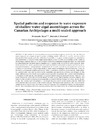Please use this identifier to cite or link to this item:
https://accedacris.ulpgc.es/jspui/handle/10553/49611
| Title: | Spatial patterns and response to wave exposure of shallow water algal assemblages across the Canarian Archipelago: A multi-scaled approach | Authors: | Tuya, Fernando Haroun, Ricardo J. |
UNESCO Clasification: | 241705 Biología marina | Keywords: | Algae Phytobenthic assemblages Hierarchical design Spatial variability Wave exposure, et al |
Issue Date: | 2006 | Publisher: | 0171-8630 | Journal: | Marine Ecology - Progress Series | Abstract: | We conducted a mensurative survey to investigate spatial variability and the effect of wave exposure at a range of spatial scales including islands (100s of km apart), locations within islands (10s of km apart), and sites within locations (100s of m apart), on the composition, abundance and distribution of shallow water algal assemblages across subtidal hard bottoms of the Canarian Archipelago (eastern Atlantic). A multi-scaled hierarchical sampling design provided the framework for quantifying the variation among samples due to spatial scale and level of wave exposure. Randomly placed 50 × 50 cm squares were deployed in shallow rocky-reefs to assess community structure and dominance. Non-parametric multivariate techniques, as well as univariate tests, provided evidence to collectively suggest that shallow water algal assemblages differed between protected (leeward) and exposed (windward) shores, with a consistency of effects across islands, while different spatial scales were also involved in the variability and patchiness of these assemblages. In this sense, differences were clearly taxon and/or group-specific. In general, the presence and abundance of frondose fucoid species was greater on exposed shores than on protected shores, whereas turf-algae dominated along the protected shores of each island. Dissimilarities between islands with regard to the overall algal assemblage generally increased with the distance between islands. In particular, the presence and abundance of fucoid species was greater in the eastern islands, while turf and bush-like algae increased in the western islands. The large-scale gradient of the oceanographic conditions in an east-to-west direction across the Canarian Archipelago provided a partial explanation for this observation although some inconsistencies were observed in the overall regional pattern. | URI: | https://accedacris.ulpgc.es/handle/10553/49611 | ISSN: | 0171-8630 | DOI: | 10.3354/meps311015 | Source: | Marine Ecology Progress Series [ISSN 0171-8630], v. 311, p. 15-28 |
| Appears in Collections: | Artículos |
SCOPUSTM
Citations
77
checked on Jun 8, 2025
WEB OF SCIENCETM
Citations
74
checked on Jun 8, 2025
Page view(s)
124
checked on Feb 1, 2025
Download(s)
107
checked on Feb 1, 2025
Google ScholarTM
Check
Altmetric
Share
Export metadata
Items in accedaCRIS are protected by copyright, with all rights reserved, unless otherwise indicated.
